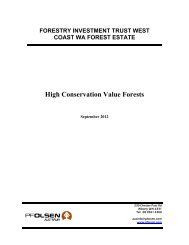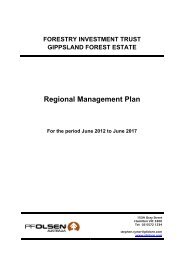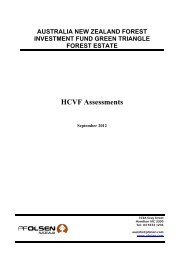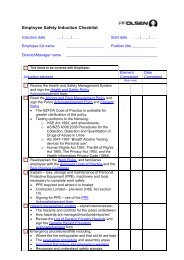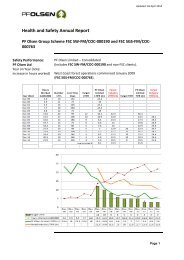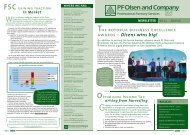How To Make More Money From Your Forestry ... - PF Olsen Limited
How To Make More Money From Your Forestry ... - PF Olsen Limited
How To Make More Money From Your Forestry ... - PF Olsen Limited
You also want an ePaper? Increase the reach of your titles
YUMPU automatically turns print PDFs into web optimized ePapers that Google loves.
HARVEST-READY SUCCESS STORY<br />
Jim Donald, Paul van der Voort (<strong>PF</strong> <strong>Olsen</strong>) and Dale Donald at the table discussing<br />
resource consent conditions and marketing strategies.<br />
You only get one chance to sell your trees and<br />
thirty years is a long time to wait. <strong>PF</strong> <strong>Olsen</strong> are PRICE<br />
GETTERS and are constantly looking at options to<br />
IMPROVE OVERALL FINANCIAL RETURNS<br />
Jim Donald<br />
Jim Donald attended a <strong>PF</strong> <strong>Olsen</strong> Harvest-Ready Seminar and by being<br />
Harvest-Ready benefited from the recent export log price increases while<br />
maintaining good domestic options. Due to forward planning the Donald<br />
Don’t miss out on GETTING<br />
THE BEST EQUIPMENT for<br />
your harvesting job!<br />
If your block requires specialist crews or equipment, you MUST<br />
be Harvest-Ready or the gear and crews won’t be available…<br />
Engineering costs typically comprise around<br />
60-80% of the total costs of harvesting<br />
operations. In many woodlot situations<br />
specialist logging equipment such as<br />
“<br />
forwarders or<br />
Harvest-line haulers<br />
provide very costeffective<br />
logging<br />
solutions. This type of<br />
equipment, however,<br />
is less common<br />
than other types of<br />
equipment. As the<br />
shortage of logging<br />
contractors gets more<br />
severe, those who<br />
will benefit from the<br />
specialist equipment will find it increasingly<br />
difficult to secure. “This could have significant<br />
implications on costs and quality of the work”,<br />
says Scott Downs, <strong>PF</strong> <strong>Olsen</strong>’s Northern South<br />
Island Manager. “If we can identify woodlot<br />
As the shortage of logging<br />
contractors gets more severe,<br />
those who will benefit from the<br />
specialist equipment will find it<br />
increasingly difficult to secure.<br />
This could have significant<br />
implications on costs and<br />
quality of the work<br />
owners who need specialist equipment early,<br />
we are in a much better position to get it<br />
scheduled for the work. This can pay big<br />
dividends for our clients and easily result in<br />
doubling of stumpage<br />
returns on remote<br />
blocks in difficult<br />
country”.<br />
Knowledge<br />
of equipment<br />
requirements in the<br />
future also enables<br />
<strong>PF</strong> <strong>Olsen</strong> to facilitate<br />
contractors gearing up<br />
with the appropriate<br />
”<br />
machinery to do<br />
the best job. This is<br />
consistent with <strong>PF</strong> <strong>Olsen</strong>’s Harvest-Ready<br />
message and represents another opportunity<br />
to ensure that woodlot owners get the best<br />
possible result during the crucial harvesting<br />
phase.<br />
family also received a sharp logging rate.<br />
Harvesting 37 hectares (25 000 tonnes) is not a small operation, nor is<br />
ensuring you have the information and support to make the best decisions.<br />
Dale Donald planted these trees 32 years ago so the returns have been<br />
long awaited, however planning and timing have been the keys to ensuring<br />
that the Donald Trust achieved a great return.<br />
Jim and Dale Donald<br />
explain that they went<br />
through a very rigorous<br />
selection process<br />
involving both their<br />
lawyer and accountant<br />
before committing to a<br />
service provider. “<strong>To</strong>tal<br />
package of professional<br />
management, marketing<br />
strategy, expected returns<br />
and risk management”,<br />
Jim and Dale Donald<br />
explain that they went<br />
through a very rigorous<br />
selection process<br />
involving both their<br />
lawyer and accountant<br />
before committing to a<br />
service provider.<br />
are what the Donald’s say made them choose <strong>PF</strong> <strong>Olsen</strong>. “Liability issues<br />
were also high on our selection criteria”, they commented.<br />
With a mix of both hauler and ground-based work the harvesting itself<br />
required specialist planning and time to book in the right crews for the<br />
conditions. It has paid off and as a result the Donald family reflect on their<br />
forestry investment as a very positive one. As Jim said “You only get one<br />
chance to sell your trees and thirty years is a long time to wait”!<br />
Getting the right gear on site at the right<br />
time is becoming increasingly difficult as<br />
harvesting levels increase.<br />
The Export Market Update and <strong>How</strong><br />
It Can Affect <strong>Your</strong> Return<br />
The graphs (right) provided by Pacific Forest Products, show the<br />
movements in US$/ JAS of Ocean freight cost to Asia and export<br />
log prices delivered to Asia.<br />
Russian Far East trees are harvested in winter and stockpiled. When spring arrives and the<br />
ports thaw they are shipped out. The impact of the spring surge of Russian log supply on Asian<br />
markets is expected to decline by June, as the inventory is shipped and the quality of remaining<br />
stored logs falls due to fungus and insect attacks on the logs. Russia recently announced future<br />
increases in export tariffs on logs. <strong>From</strong> a current rate of 6.5% to 80% by 2009 however, we<br />
believe there have been recent moves to soften their stance due to pressure from countries like<br />
Japan and Sweden.<br />
The proposed tarrif increases could have a huge impact on log prices in the Asia region from<br />
July this year onwards. In addition, supplies of export logs from Russia are likely to decline if<br />
the intended consequence of increased (Russian) domestic log processing is achieved. The<br />
big importers in the Asia region are China ( 30 million m 3 annually) and Japan (5 million m 3<br />
annually). Predictably these two counties are applying as much pressure as possible on<br />
Russia to re-evaluate its proposed tariff schedule. Ocean freight rates continue to climb due to<br />
continued high demand for ships from China and other rapidly expanding economies in Asia.<br />
Some of the shipping shortages are due to the inability of Australian mineral exporting ports to<br />
turn around the waiting ships quickly enough. In a recent air flight up the Queensland coast<br />
we saw large numbers of ships anchored off Glandstone awaiting a berth. The Australian<br />
newspaper in February reported that it took 21 days to gain a berth at the Newcastle coal<br />
terminal. While many of these ships are larger than those used in the logging trade the impact<br />
flows on. Apparently the shippers would rather put up with these long delays than crossing<br />
the Tasman to pick up New Zealand logs.Any reduction of these rates will depend on either a<br />
reduction in exports or the building of new tonnage. Ship builders are reported to have full order<br />
books and older ships are being refitted and kept in service past their usual lifespan of around<br />
25 years.<br />
The New Zealand dollar has continued to appreciate rather than fall as was predicted. The most<br />
recent rises in April are expected to pull the returns to New Zealand forest owners down over the<br />
next few months.<br />
<strong>How</strong>ever, the strong Asian demand for logs means customers are paying similar US$ prices for<br />
logs at destination ports as those that occurred in the 1993 log price spike. With supply being<br />
boosted by Russia for the next 2 to 3 months it is unlikely that customers will pay more for their<br />
logs. Any wharf-gate price improvement in the short-term will be dependent on favourable<br />
movements in the exchange rate and shipping costs. In the latter half of the year the impact of<br />
the Russian tariff increases may result in improved New Zealand grower returns.<br />
<strong>PF</strong> <strong>Olsen</strong> Ltd’s CEO Peter Clark has just returned from a trip to SE Asia including Malaysia, Laos<br />
and Vietnam. His comments are that there is still a great deal of timber used in all the countries<br />
visited as they rapidly expand their infrastructure and manufacturing sectors. The indigenous<br />
forests of SE Asia have been heavily depleted, but remain the primary source of the industrial<br />
plywood and structural solid timber for which there is no obvious alternative except at high cost<br />
(either in $ terms or environmentally). The current level of indigenous forest cut in Indonesia,<br />
Malaysia and Indochina remains well above the sustainable level. Within the next 10 years we<br />
can expect to see a significant reduction in the output from the residual natural forests. Logged<br />
over forest is more likely to be converted to alternative uses such as oil palm plantation and<br />
the chances for really large forest plantation development programmes to replenish the lost<br />
hardwood forest volume appear to be low in SE Asia.<br />
Clark’s opinion is that New Zealand plantation resource will be seen as<br />
a good alternative once the increasing demand meets up with the<br />
diminishing supply of tropical logs.<br />
Harvest costs and Infrastructure Constraints<br />
Harvest and delivery costs have increased sharply driven by capacity<br />
shortages (plant/equipment and labour) and fuel costs. As harvesting<br />
levels lift, shortages of logging contractors and logging trucks for log<br />
transport are biting hard. One log transport operator reported that there<br />
are 22% less log trucks operating in the southern north island currently<br />
compared to 2002. The other infrastructure limitation that has occurred<br />
this year relates to port operations. All the major log export ports<br />
have suffered congestion at some time this year and had to suspend<br />
deliveries. This can have significant adverse flow on effects for woodlot<br />
operations.<br />
What can Forest Owners do to Maximise returns<br />
in a volatile market?<br />
Whilst we would love to be able to accurately forecast timber, freight<br />
and foreign exchange markets, the reality is that we can’t. The best<br />
investment for a forest owner with timber near maturity is to get<br />
HARVEST-READY. The best way to minimise potential disruptions from<br />
the increasing contractor shortage is to get HARVEST-READY. Please<br />
call your local <strong>PF</strong> <strong>Olsen</strong> representative directly or contact us on 0508<br />
<strong>PF</strong>OLSEN (0508 736 5736) to find out how we can help you get ready<br />
for harvesting.<br />
$60. 00<br />
$50. 00<br />
$40. 00<br />
$30. 00<br />
$20. 00<br />
$10. 00<br />
$0. 00<br />
$140.00<br />
$130.00<br />
$120.00<br />
$110.00<br />
$100.00<br />
$90.00<br />
$80.00<br />
$70.00<br />
$60.00<br />
$50.00<br />
$40.00<br />
$30.00<br />
250<br />
200<br />
150<br />
100<br />
50<br />
0<br />
D ec-<br />
90<br />
Dec-<br />
91<br />
D ec-<br />
92<br />
Dec-<br />
93<br />
Dec-<br />
94<br />
S hipping R at es 1:1 US D per Ja s<br />
D ec-<br />
95<br />
Dec-<br />
96<br />
D ate<br />
Source: MAF (Prices are adjusted for inflation.)<br />
D ec-<br />
97<br />
Dec-<br />
98<br />
Dec-<br />
99<br />
Dec-<br />
00<br />
Dec-<br />
01<br />
Average USD CFR Price by Grade 1996 to 2007<br />
1996 1997 1998 1999 2000 2001 2002 2003 2004 2005 2006 2007<br />
D ec-<br />
02<br />
Dec-<br />
03<br />
L O NG T E RM PRICE M OVE ME NT S F OR S E L E CT E D L O G G RA DE S<br />
Mar-97 Mar-98 Mar-99 Mar-00 Mar-01 Mar-02 Mar-03 Mar-04 Mar-05 Mar-06 Mar-07<br />
Year<br />
A Grade K Grade KI Grade Pulp<br />
The graph below shows the wharf-gate/mill door log prices over the<br />
past 10 years.<br />
D ec-<br />
04<br />
E xport K P 1 S 2 Domestic P ulp<br />
When You Engage <strong>PF</strong> <strong>Olsen</strong> to be<br />
your Harvesting Manager you stay in<br />
Control of when to Harvest.<br />
Rest assured that if you select <strong>PF</strong> <strong>Olsen</strong> as your service provider it does not mean you lose<br />
control of when to harvest your woodlot. “The decision of when to harvest your woodlot<br />
is multifaceted”, says Peter Weblin, <strong>PF</strong> <strong>Olsen</strong>’s Marketing Manager. “We find that woodlot<br />
owners that are most comfortable with their decision to harvest their woodlot (both prior to<br />
and after the harvesting) are those that look at the whole picture. This includes considering<br />
the performance of the woodlot, performance of the market and personal and on-farm<br />
considerations. Woodlot owners who over-emphasise one component in their decisionmaking<br />
(and its often the market) are usually the ones who regret their decision in hindsight.<br />
<strong>PF</strong> <strong>Olsen</strong>’s role in deciding the best time to harvest is to provide factual information to its<br />
client’s and act as professional sounding board. “Excavators, bulldozers, skidders and/or<br />
cable haulers will not suddenly come rumbling onto your property once you engage<br />
<strong>PF</strong> <strong>Olsen</strong>”, says Weblin. “Well not unless that is what the client wants (and appropriate<br />
contractors are available)”. And even if harvesting has commenced and our client wants it<br />
stopped for some reason, that is fine. That’s a client’s right. “There may be costs associated<br />
with this decision”, cautions Weblin, “such as losing market access or costs of having to<br />
bring a contractor back to the site. These will be explained to the woodlot owner so they can<br />
make an informed decision”.<br />
P rices us ed<br />
D ec-<br />
05<br />
Dec-<br />
06




